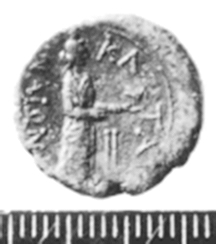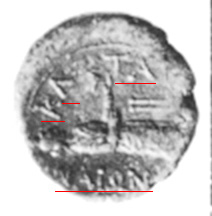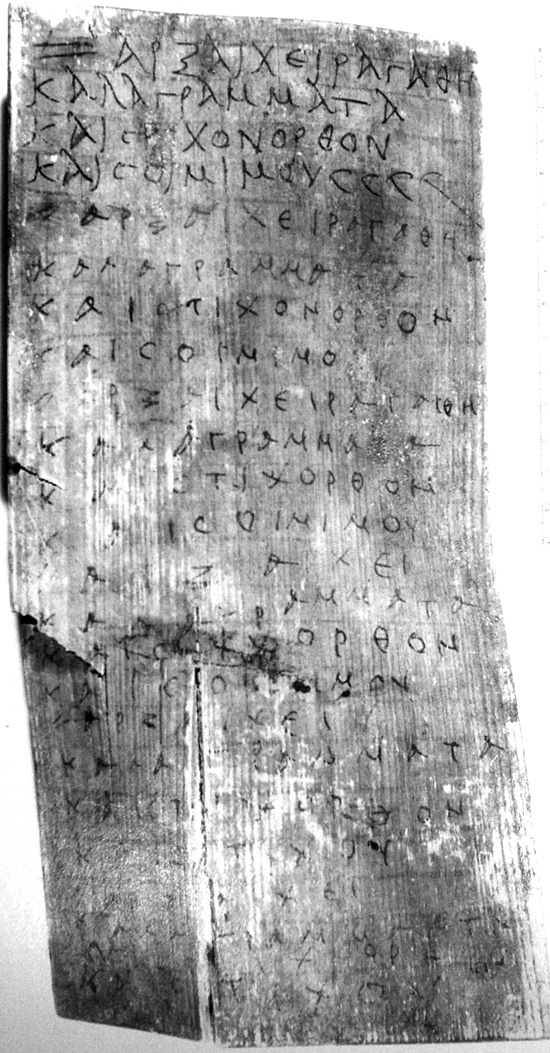

The Hearst Museum collection contains many ancient coins, but in the past two decades the Department of Classics has also been the beneficiary of several gifts of coins from collectors A. L. Hilliard and H. Lindgren. Many ancient coins have inscriptions in Greek or Latin.
Here is an image of the reverse of a bronze coin of the 3rd or 2nd century BCE from Catana in Sicily (from a Lindgren donation; inv. 1999-014). The figure represented is the goddess Isis holding a bird. The right image is turned ninety degrees so that the inscription can be read more easily.


On the right side, following the curve of the die, are the inscription-style letters ΚΑ and ΤΑ (separated by the image of the bird on Isis's outstretched hand), and on the left side, following a straight course, are the letters ΝΑΙΩΝ (the first letter is incomplete because the impression is off-center). Read together, this is the genitive noun ΚΑΤΑΝΑΙΩΝ, "of the Catanians," indicating that the coin is produced by the government of the city of Catana.
Flat tablets of wood of various thicknesses could be used as writing material. Sometimes the surface of the wood was covered with white paint and then black ink was used for writing, and sometimes writers used pen and ink on the bare wood. Tablets sometimes have holes on one edge to allow for tying several tablets together or affixing a loop so that the tablet can be hung.
The image below shows a school tablet found at Tebtunis in 1899-1900 and now preserved at the Phoebe Apperson Hearst Museum of Anthropology (inv. 6-21416). The wood has not been painted before being used for writing, and there is also writing on the other side. There are holes in the tablet, but they are not easy to see in this image. The teacher has written four lines at the top and a student has practiced writing by imitating the lines several times. But the student makes several mistakes, and copies each version from the one immediately above it, so once a mistake has been made, it is repeated in all the subsequent versions. On the basis of the writing style and the reported location of the find, the date of this writing is assigned to the 2nd or 3rd century CE.

Here is a transcription of the first four lines, written by the teacher. The first line has a double horizontal stroke at its beginning, and the fourth line is provided with filler marks at the end to make it similar in length to the others.
=ΑΡΞΑΙΧΕΙΡΑΓΑΘΗ
ΚΑΛΑΓΡΑΜΜΑΤΑ
ΚΑΙΣΤΙΧΟΝΟΡΘΟΝ
ΚΑΙΣΟΙΜΙΜΟΥ<<<<
The first three lines form a dactylic hexameter verse, and the verse has been found on other school tablets. In modern font, it runs:
ἄρξαι, χεὶρ ἀγαθή, καλὰ γράμματα καὶ στίχον ὀρθόν.
"Begin, good hand, fine letters and a straight line (of writing)."
The last line is an exhortation to the student to imitate the example (and the student imitates the exhortation as well as the example). The form ΣΟΙ is probably a phonetic error for nominative ΣΥ rather than the dative of the pronoun, since in later Greek the sounds of οι and υ had become identical.
καὶ σοὶ μιμοῦ.
"And imitate (this) yourself."